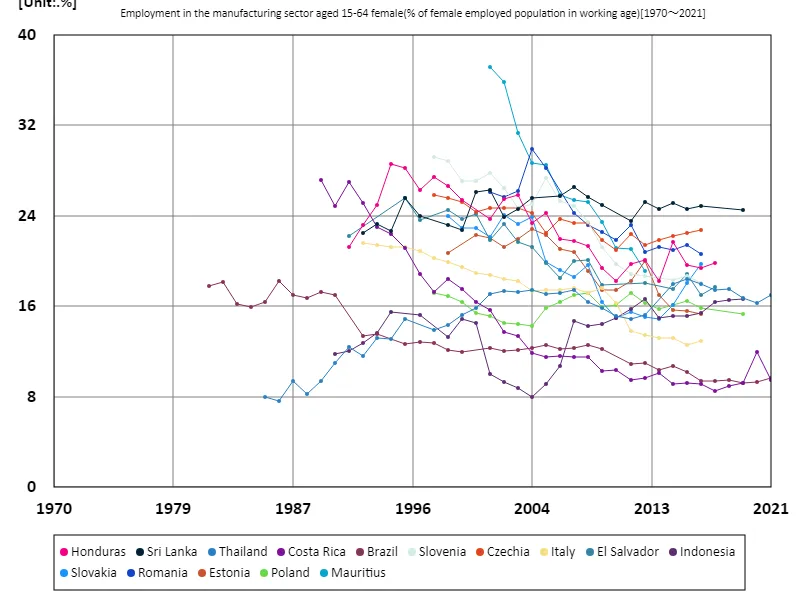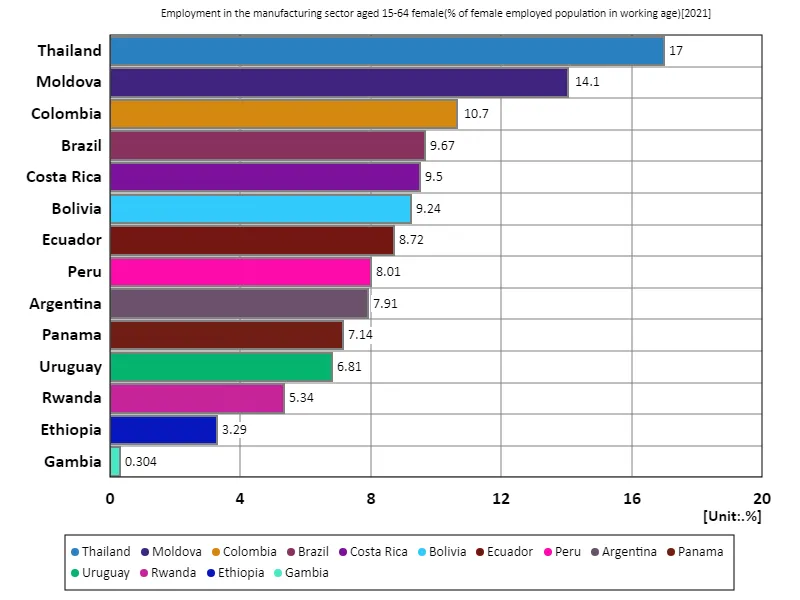- Abstract
- Employment rate in the industrial sector for women aged 15-64 (percentage of working-age women in the labor force)
- Employment rate in the industrial sector for women aged 15-64 (percentage of working-age female employed population) (Worldwide)
- Employment rate in the industrial sector for women aged 15-64 (percentage of working-age female employment in the labour force) (World, latest year)
- Reference
Abstract
Peru has the highest employment rate among women aged 15-64 at 68.1%, indicating a unique trend in the country’s labor market. Female labor force participation has increased globally in recent years, but the rate varies widely across countries. Peru’s high employment rate can be linked to its economic growth and the structure of its labor market. For example, Peru has a large informal sector, which may be due to the fact that women are more likely to work in this sector. On the other hand, developed countries often have robust social security and childcare support systems, and female employment rates tend to be high. The example of Peru also shows that employment rates are closely linked not only to economic growth but also to the characteristics of social institutions and the labor market.
Employment rate in the industrial sector for women aged 15-64 (percentage of working-age women in the labor force)
Data from 1981 to 2021 show that the peak employment-to-population ratio for women aged 15-64 years reached 80.2% in Moldova in 2017. This high employment rate can be attributed to Moldova’s economic situation and social structure. Moldova was in a period of economic transition that would have encouraged women to actively participate in the labor market. However, the employment rate has now fallen to 64%, and there are several possible factors that can explain this. Economic fluctuations and social changes, such as a shrinking labour market or increased immigration, may be contributing factors. Overall, female employment rates have increased in many countries since the 1980s, but some have recently stagnated or declined. While female labor market participation remains stable and high in developed countries, it is greatly influenced by economic fluctuations and changes in social systems in developing countries. The example of Moldova also highlights the fact that employment rates respond sensitively to changes in economic conditions and social policies, and that sustainable policies and systems need to be developed.


The maximum is 29.9%[2004] of Romania, and the current value is about 69.1%
Employment rate in the industrial sector for women aged 15-64 (percentage of working-age female employed population) (Worldwide)
According to data from 1981 to 2021, the employment rate for women aged 15-64 reached its highest level in Moldova in 2017 at 80.2%. This indicates that Moldova was in a period of economic transformation and many women were participating in the labor market. However, the current employment rate has fallen to 64%, which may be due to economic instability and social changes. In a country like Moldova, labour market contractions, migration and economic fluctuations have a significant impact on female employment rates. Overall, female employment rates have been increasing in many countries since the 1980s, but more recently economic hardships and changes in social policies have caused fluctuations in employment rates. In developed countries, labour market participation is stable, whereas in developing countries it is directly affected by economic and social changes. Moldova provides an important case study in how economic conditions and social policies affect employment rates.


The maximum is 37.2%[2001] of Mauritius, and the current value is about 51.3%
Employment rate in the industrial sector for women aged 15-64 (percentage of working-age female employment in the labour force) (World, latest year)
According to 2021 data, Peru had the highest employment rate for women aged 15-64 years old relative to their population at 68.1%, while the overall average was 51.7%. Peru’s high employment rate is thought to be largely due to the active participation of women, particularly in the informal sector. While the expansion of the informal economy has increased employment opportunities, problems also exist regarding working conditions and treatment. The average value of 51.7% indicates that female labour market participation is still progressing in many countries, but there are large regional variations. Overall, female employment rates vary widely depending on economic development, social institutions, and cultural factors. While developed countries have achieved relatively high employment rates thanks to widespread access to education and well-developed labor markets, developing countries face economic constraints and social barriers. Peru’s high employment rate, combined with the specific economic conditions of the region, highlights the importance of women’s economic participation.


The maximum is 17% of Thailand, the average is 8.4%, and the total is 118%



Comments